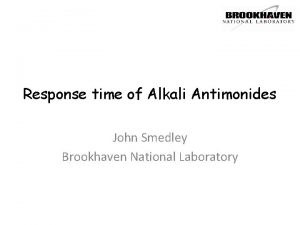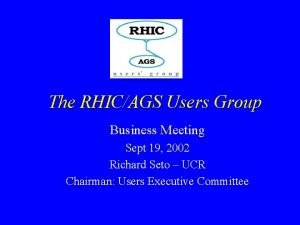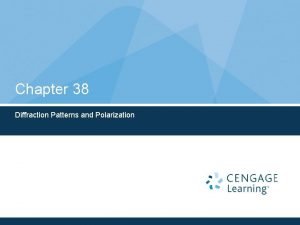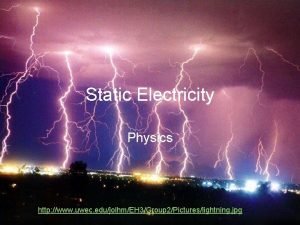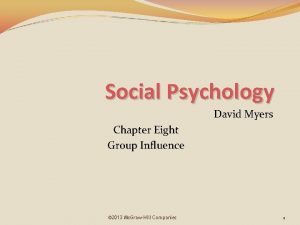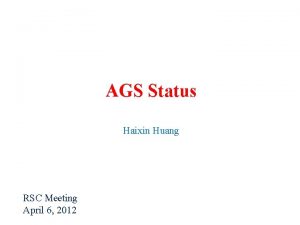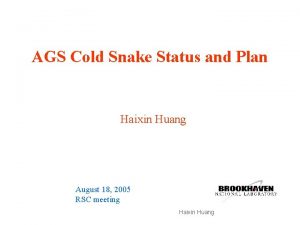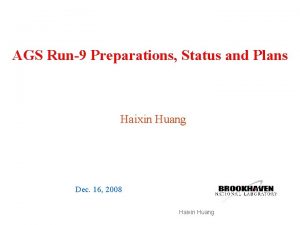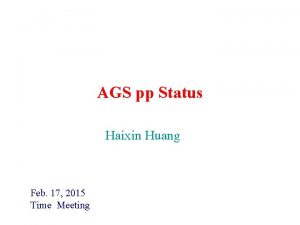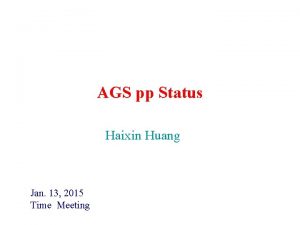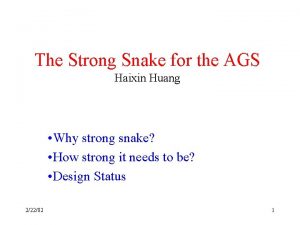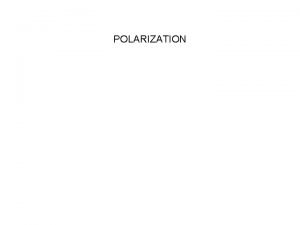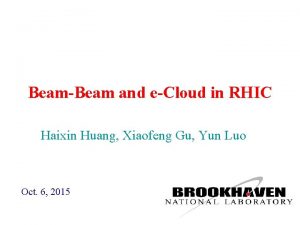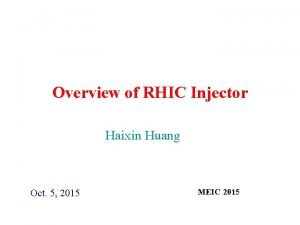AGS Performance and Polarization Haixin Huang April 4















- Slides: 15

AGS Performance and Polarization Haixin Huang April 4, 2008 RSC Meeting

AGS Polarization • The best polarization level of this run was 60% with 1. 5*1011. Lower than 65% reached in run 6. • Polarization at injection was about 4% (relatively) lower than run 6. • Steeper horizontal polarization profiles than run 6. • The intensity dependence was benign after switching to run 6 setup. • The orbit harmonics around 36+ resonance drift from time to time. • Different polarization were measured with different nx path.

AGS –RHIC Inj. Polarization Ratio fill 10001 9998 9997 9996 9992 9991 9990 AGS 50. 99+-2. 49 52. 47+-2. 50 48. 18+-2. 52 50. 25+-2. 89 54. 91+-3. 04 56. 45+-2. 50 42. 74+-2. 48 Blue 53. 33+-2. 41 61. 32+-3. 27 49. 04+-2. 76 53. 56+-2. 75 56. 03+-2. 76 53. 39+-2. 79 52. 29+-2. 06 Yellow Intensity (AGS) 49. 94+-2. 06 1. 945*1011 56. 76+-2. 11 1. 175*1011 47. 78+-2. 05 1. 917*1011 53. 20+-2. 05 1. 640*1011 52. 53+-2. 05 1. 342*1011 49. 55+-2. 05 1. 599*1011 52. 71+-3. 00 1. 677*1011 Average ratio of RHIC fills of last five days: Blue Inj. /AGS=1. 07; Yellow Inj. /AGS=0. 96

Polarization with Different nx Path P=58% P=45%

Ramp Polarization Measurements The intensity for the two ramp measurements were about the same: 1. 3*1011. The polarization level at the extraction is similar. The history of polarization loss on the ramp could be very different. The regions with less polarization this year. Hinting loss in lower energy (before and around 0+).

Ramp Polarization Measurements (2) No visible polarization loss in run 8 in this energy region

User 2 Polarization Profile is Slightly Better Than Ones on User 4 (Fanglei Lin) User 2

Horizontal Polarization Profiles 2008 Mar. 01 10%CS (User 2) 2008 Feb. 24 10%CS (User 4) 2008 Feb. 20 10%CS (User 4) 2008 Feb. 09 10%CS (User 4) 2006 10%CS 2006 14%CS Beam size (mm) 0. 98 1. 108 1. 1916 1. 0301 0. 942 0. 912 Measured / fitted center polarization P 54. 81 (56. 62) 49. 83 (50. 96) 54. 26 (55. 18) 55. 34 (57. 93) 65. 35 (65. 5) 59. 39 (59. 26) P 0 fit 60. 11 +/- 0. 055 59. 63 +/- 0. 065 60. 68 +/- 0. 078 62. 36 +/- 0. 06 67. 97 +/- 0. 87 62. 83 +/- 1. 05 P/ P 0 fit 0. 942 0. 855 0. 909 0. 929 0. 964 0. 943

AGS and Bt. A Emittances • Emittances measured by AGS IPM near injection are twice as measured in run 6, while emittances measured at first Bt. A multi-wires are similar to in run 6: H, V (13 pi, 4 pi). This is by far the most significant difference between the two runs. Nevertheless, the extraction emittances are only slightly larger this run. • Modeling Bt. A line (multiwire A 15 included) does not yield consistent emittances from Booster to AGS. More work needs to be done for the modeling.

AGS and Bt. A Emittances (2) • It is clear from scraping beam after transition that there is emittance growth correlated with intensity increase: we could not generate a brighter beam in the AGS. There is emittance growth early in the cycle. A down ramp emittance measurement also points to the early part of the cycle for the growth. It could be due to either space charge or instability near injection. Simulation will follow. • The linac upgrade this summer will reduce emittance out of linac. We need to maintain the smaller emittances in the AGS. • The beam emittance (rf off at flattop) are different now from run 6: 2/19/08 H 16 p, V 13 p with 1. 3*1011 inj. on the fly 3/06/08 H 13 p, V 17 p with 1. 4*1011 inj. with front porch 5/11/06 H 11. 4 p V 16 p with 1. 6*1011 5/12/06 H 10. 4 p V 15. 2 p with 1. 36*1011

IPM Emittances at AGS Extraction with RF off (Kevin Brown) Higher energy case is better but still not as good as injection with front porch.

Finding Hidden Knobs • How? • One way is to do data mining by looking for any correlation of the polarization vs. emittance, orbits (horizontal and vertical), injection setup, extraction setup……. . • Ramp measurement analysis. • More realistic spin simulation (including sextupoles, orbit bumps…. ) • Comparing the polarization measurements with different horizontal tunes • Comparing the polarization measurements with different harmonics.

Plans to Raise AGS Polarization at Extraction • Extraction-on-the-fly from AGS to RHIC. The low level RF upgrade should keep this option feasible. • H=6 for AGS injection to reduce the emittance growth (if space charge is the problem). Lower the RF voltage near injection would also help. • Add a (pair of ) quad(s) to generate 80 horizontal tune jumps at all weak horizontal resonances. • Raise AGS injection energy to fight the emittance growth and large orbit distortion (affecting polarization and intensity) associated with the partial snakes. Ideally, we would like to raise energy by three units of Gg (~1. 5 Ge. V).

Tune Jump for Horizontal Resonances (Thomas Roser) • Add a single quad for this purpose. • Minimum change of nx of 0. 01 in 100 ms-> requires d. B/dx of 0. 5 T/m and 300 Gauss. This will double the resonance crossing speed. • Operation issue: has to be deadreckoning of timing. • Searching for existing P/S & magnet(s). • Benefit on polarization transfer efficiency(16 pi beam): Crossing Pf/Pi(peak) Pf/Pi(whole) regular speed 0. 903 0. 815 Double speed 0. 950 0. 903 4 X speed 0. 975 0. 950 Spin tune 36+nx 55 -nx 36+ny

Raise AGS Injection Energy • Raise injection energy to Gg=7. 5. • We think there are still some polarization loss near injection. • It will greatly reduce the optical distortion at lower energies. • The tune would have to be raised faster as the 0+ in the AGS is closer. The 0+n in the Booster has to be crossed. A solenoid snake can be used for this correction. It can’t be too strong so that the injection spin matching would not be a headache. A ~5% partial snake is needed to overcome 0+ in the Booster. Need confirmation by tracking. Remaining issues: Spin tracking in the Booster. Injection kicker and Bt. A magnets compatibility. Simulation on the space charge effects.
 Ags logins
Ags logins Role of hr in change management
Role of hr in change management Periodic table tablecloth
Periodic table tablecloth John smedley ags
John smedley ags Rhic ags users meeting 2020
Rhic ags users meeting 2020 Goto/ags
Goto/ags Interference diffraction and polarization
Interference diffraction and polarization Module 74 ap psychology
Module 74 ap psychology Deindividuation psychology definition
Deindividuation psychology definition Group polarization example
Group polarization example Charge by polarization
Charge by polarization Social trap example
Social trap example Groups tend to loaf less when
Groups tend to loaf less when Social trap example
Social trap example Group polarization vs groupthink
Group polarization vs groupthink Group polarization example
Group polarization example



